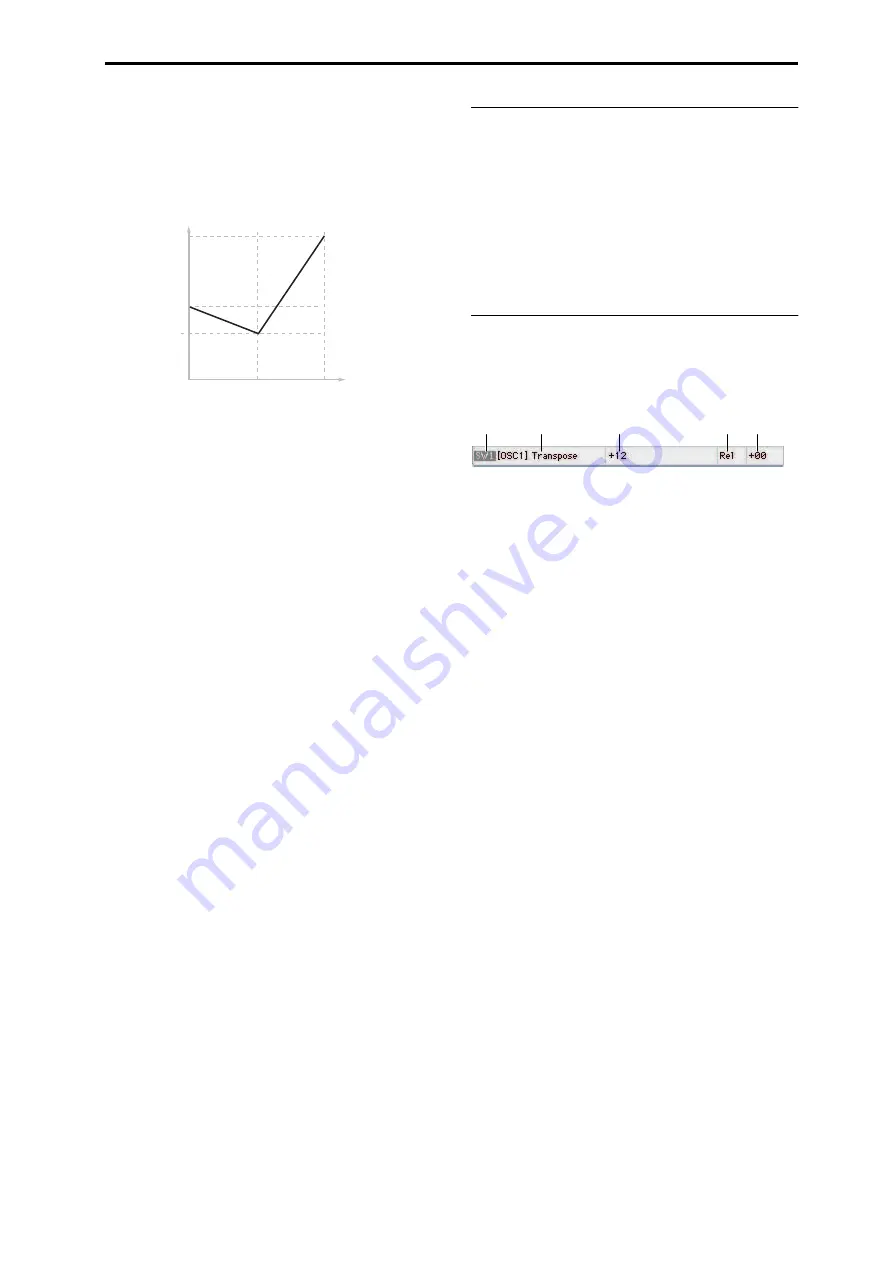
PROG P0: Play 0–7: Tone Adjust
7
For instance, if the EG Intensity is set to a negative value,
Relative Tone Adjust values will range from 0 to –99, the
inverse of the diagram above. EG Sustain works differently;
if it’s set to a negative value, Tone Adjust values range from
0 down to the programmed value, and then up to +99, as
shown below.
Relative Tone Adjust parameter scaling: EG Sustain
Meta
parameters don’t affect Program parameters directly.
Instead, they affect the way that other Tone Adjust
parameters work. For instance,
Multisample Min #
and
Max #
set the minimum and maximum values of the Tone
Adjust
Multisample
parameter.
Saving Tone Adjust Edits
Tone Adjust edits are saved in two different ways,
depending on whether the parameter is
Relative
or
Absolute
. (For more information, please see “Absolute
(Abs), Relative (Rel), Meta parameter,” below.)
Edits to
Relative
parameters affect the sound immediately,
but don’t change the underlying Program parameter
settings until the Program is saved. When the Program is
saved, the M50 calculates the combined effects of Tone
Adjust and dedicated CC modulation (from the Real Time
knobs, for instance), and saves the results into the Program
parameters directly. At that point, all of the Relative
parameters are reset to 0.
Edits to
Absolute
parameters are immediately reflected in
the corresponding on-screen parameters, and vice-versa.
Tone Adjust and MIDI SysEx
The Tone Adjust edits all send and receive MIDI System
Exclusive messages. You can use this to record and play
back Tone Adjust edits with a sequencer, including the built-
in sequencer.
Note:
System exclusive messages are not Tone Adjust
parameters; they are linked to the actual value. For example,
if a slider in the display is assigned to control filter
resonance, and you move this slider while recording to the
sequencer, the slider movement will be recorded, but the
change in filter resonance will not be recorded. This means
that if you later reassign the Tone Adjust parameter to
control
LFO1 Speed
, playing back the sequencer will cause
the LFO speed (not the filter resonance) to change.
Interaction between Tone Adjust and MIDI CCs
A number of the Common Tone Adjust parameters can
affect parameters which are also modulated by dedicated
MIDI CCs. The specific CC numbers are noted in the
descriptions for the individual Tone Adjust parameters. For
more information, please see “Tone Adjust Parameters” on
page 9.
Tone Adjust and the CCs work independently. It’s possible,
for instance, for Tone Adjust to reduce the value of a
parameter, and then for a CC to increase it again.
Tone Adjust scales the parameter first, and then the CC
scales the result of the Tone Adjust.
0–7a: Program Select & Tempo
Bank (Bank Select)
[A...E, GM, g(1)...g(9), g(d)]
Program Select
[A...E: 000…127, GM, g(1)...g(9),
g(d): 001…128]
(Tempo)
[040.00...300.00, EXT]
This area displays information about the program selected
for editing: the program bank/number/ name, and the
tempo used to control the arpeggiator etc. For more
information, please see “0–1a: Program Select” on page 2.
0–7b: Selected parameter information
Selected parameter information
This status line shows detailed, read-only information about
the currently selected Tone Adjust parameter.
Control
[SW1...8, SL1...8]
This is the controller in the display to which the Tone Adjust
parameter is assigned.
SW:
Switch
SL:
Slider
Assignment
This shows the full name of the parameter assigned to the
controller. You can change this using the
Assign
parameter,
below.
Value
This shows the current value of the parameter. The range of
values will vary depending on the parameter assigned to the
control.
Type
[Rel, Abs, Meta]
This shows the type of parameter, which relates to how edits
to the parameter are adjusted and saved. For more
information, please see “Absolute (Abs), Relative (Rel),
Meta parameter” on page 6.
Stored Value
This shows the original value of the parameter, before the
effects of Tone Adjust. It applies only to Tone Adjust
parameters which control a single Program parameter.
If you un-assign a
Relative
parameter from a control, it will
revert to this value.
99
–99
00
Relative Tone Adjust Value
Parameter
Value
As Programmed
0
–99
+99
Control
Assignment
Value
Stored Value
Type
Summary of Contents for M50-73
Page 1: ...2 E Parameter Guide ...
Page 86: ...Program mode 78 ...
Page 132: ...Combination mode 124 ...
Page 222: ...Sequencer mode 214 ...
Page 297: ...Effect Mixer Block Diagrams Main Outputs 289 ...
Page 418: ...Appendices 410 ...
















































